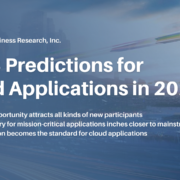Top 3 Predictions for Cloud Applications in 2022
SaaS will see new vendors, bigger workloads and more customization
Consistent growth masks considerable change in SaaS during 2022
The expectations for what cloud can offer customers have shifted, and in no market is that more clear than with cloud applications and SaaS. The financial benefits of cloud, both the lower overall cost and the shift to an operating expense pricing model, were the early attractions as customers moved low-risk applications to the cloud. Now that more mission-critical enterprise applications are being moved, cost is still a consideration for major SaaS purchases, but it is no longer the sole driving factor influencing adoption decisions. The constant stream of innovation, more frequent updates, and ability to align cloud to changing business requirements have taken over as the most attractive elements of SaaS solutions.
That high-level value proposition will persist into 2022, making SaaS the largest cloud market in terms of revenue and one that will continue to grow in the double digits year-to-year. It may sound like the same old story, but a shifting set of trends will drive this growth. First, while large providers like SAP, Oracle and Microsoft remain the mainstays of the market, born-in-the-cloud providers have matured greatly over the past few years, best highlighted by Salesforce whose front-office SaaS portfolio aligned well with the adoption patterns of the enterprise, setting the vendor on a course to eclipse SAP as the largest enterprise application provider in terms of revenue by the end of 2021.
The success of Salesforce and other cloud pure plays like Workday has been recognized by a growing ecosystem of nontraditional ISVs that are entering the market to capitalize on the opportunity. Systems integrators, small managed services partners, and cloud platform providers will all package solutions that are sold as SaaS to end customers. Second, the larger, mission-critical services in the ERP category of workloads will see increased adoption. That shift carries significant dollar investments not only in the SaaS offerings being purchased but also in the associated services and technologies that support those environments. Third, the need for customization based on the business process, existing technology, and vertical industry increases the value of broad ecosystems that extend the core SaaS offerings.
This dynamic is supported by TBR’s 1H21 Cloud Applications Customer Research, which found that the value of ISV ecosystems was not just in filling gaps in vendors’ portfolios but also, more critically, in increasing the stickiness of vendors’ offerings within clients’ environments. This dynamic will result in PaaS capabilities becoming a key differentiator for vendors in the overall public cloud market. So while growth will continue in SaaS, it will mask big changes occurring in the market during the coming year.
2022 Cloud Applications Predictions
- The SaaS opportunity attracts all kinds of new participants
- Cloud delivery for mission-critical applications inches closer to mainstream
- Customization becomes the standard for cloud applications
Learn more in our webinar 2022 Predictions: Cloud
Download a free copy of TBR’s Top 3 Predictions for Cloud Applications in 2022
Telecom Business Research’s 2022 Predictions is a special series examining market trends and business changes in key markets. Covered segments include cloud, telecom, devices, data center, and services & digital.




Leave a Reply
Want to join the discussion?Feel free to contribute!